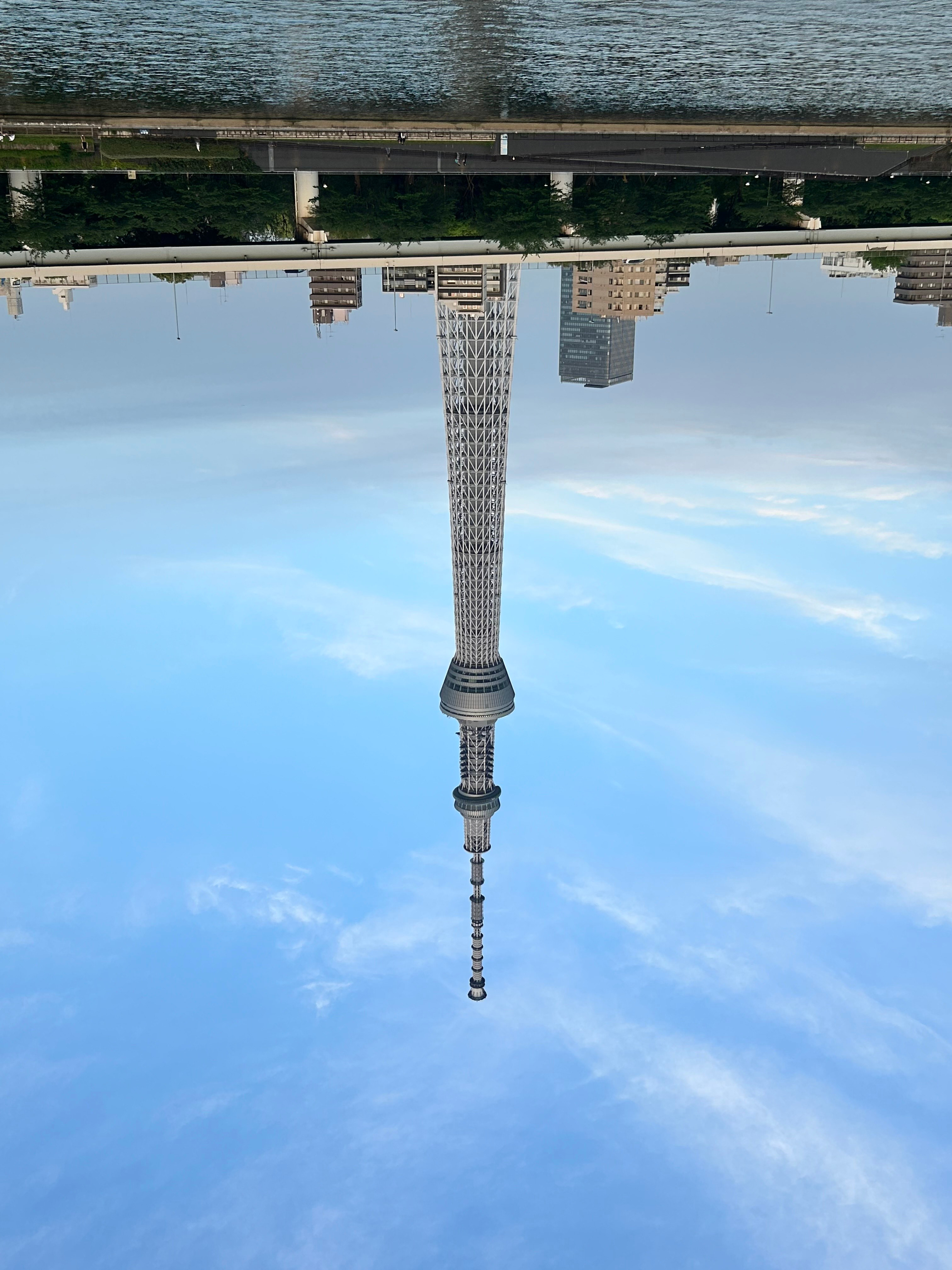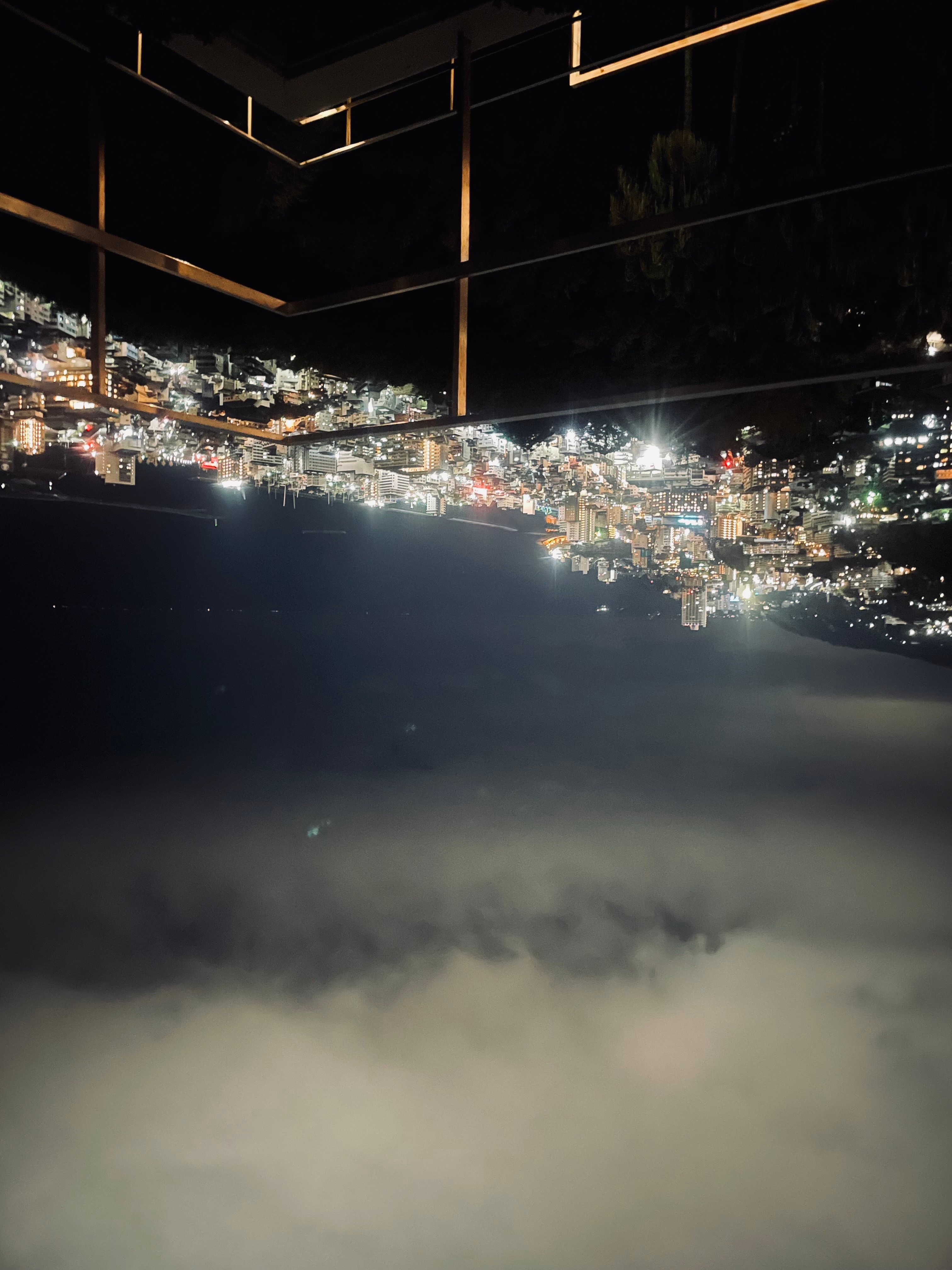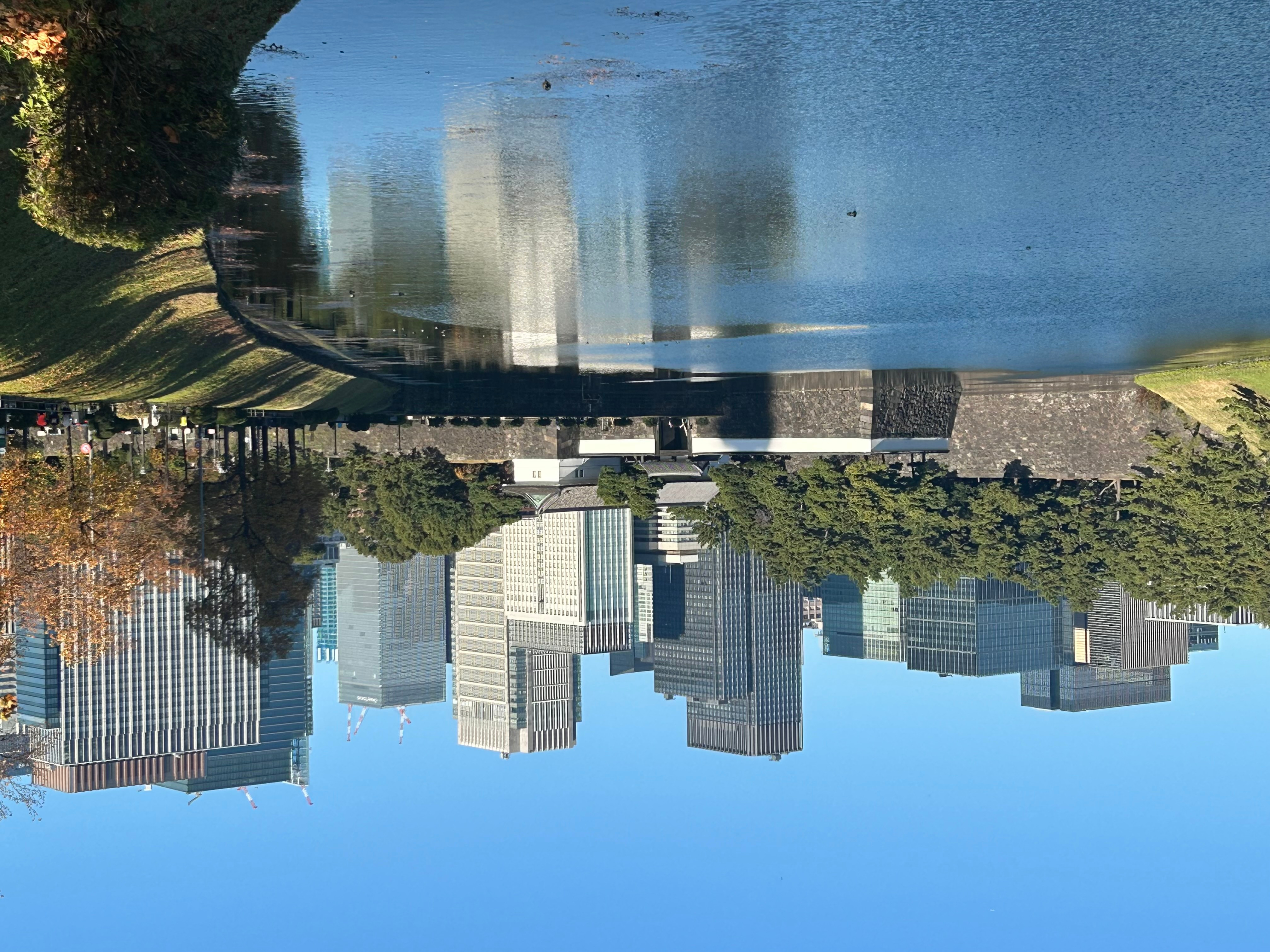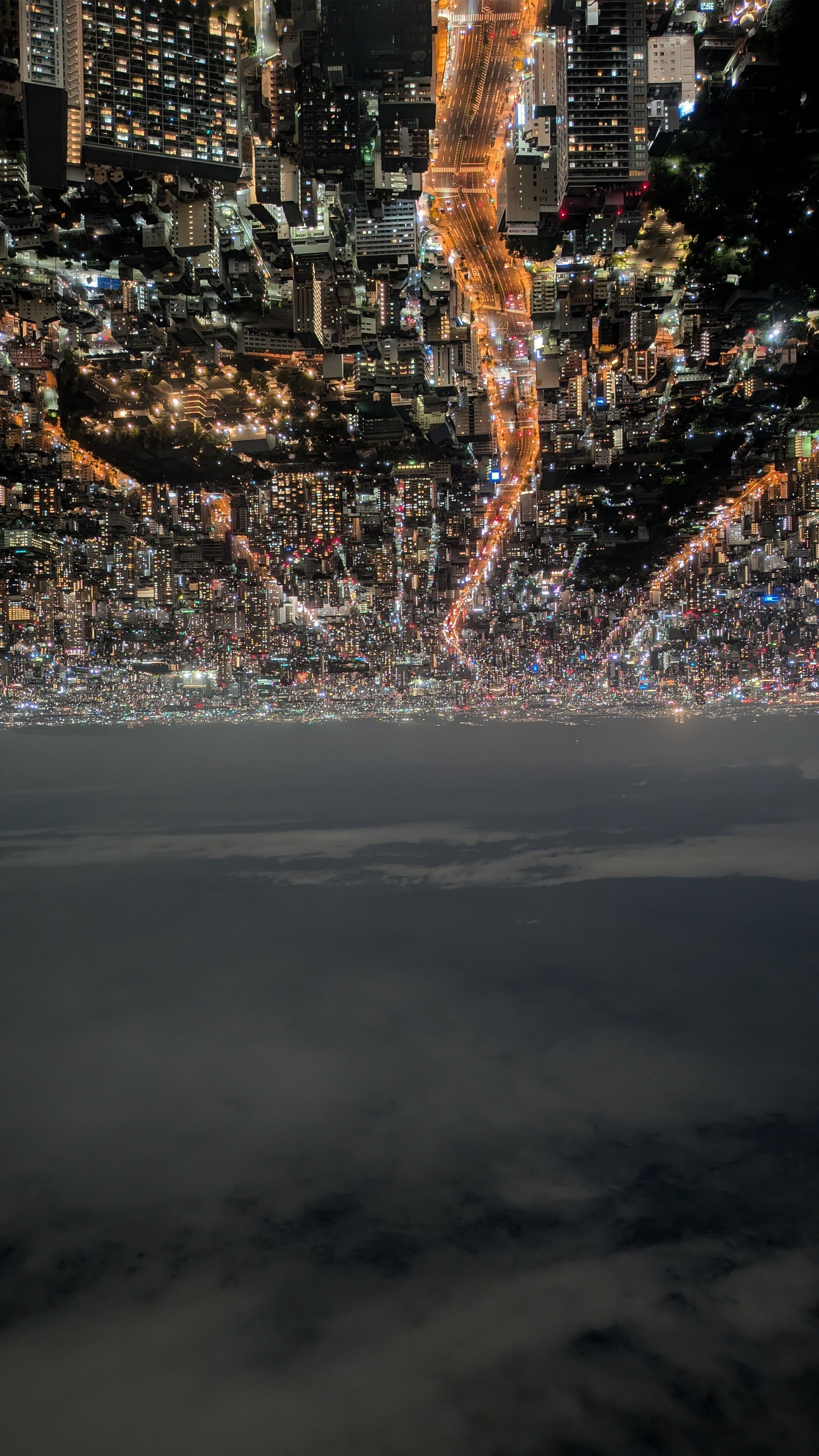ʒиN 13 : 股覗き MATANOZOKI
This issue took place thanks to the efforts of Professor Wakana KONO and the participation of first-year students of the Department of Cultural Studies, Faculty of Education, Waseda University.

鴻野わか菜
Wakana KONO
宮山香里「空の根っこ -Le Radici Del Cielo-」
Kaori Miyayama’s work “The Roots of Heaven”
須沼神明社 長野県大町市
Sunuma Shinmeisha Shrine, Omachi, Nagano
2024年11月4日
4 November 2024
長野県大町市を初めて訪れたのは、2016年冬。翌年に開催される第1回北アルプス国際芸術祭に備えて、ニキータ・アレクセーエフと視察に行った折でした。ニキータは、日本の古典文学にも登場する「遠くからは見えるのに、近くに行くと見えなくなる」という幻の木、帚木を生涯描き続けてきました。帚木は彼にとって、手に入らない幸福、ユートピアの象徴でした。そして驚いたことに、帚木は長野県阿智村に実在する木でもあったのです。その長野県で国際芸術祭が始まることになり、北川フラムさんがニキータを招待してくださることになりました。
初めて日本に来たニキータは、盆栽、看板、風習などあらゆることに関心を持ち、彼の視点を共有することによって、慣れ親しんだ世界が新たな光と色彩を帯びるかのようでした。大町で彼は霊松寺の銀杏の伝説に微笑み、石仏の豊かな表面に見入り、初めて見る料理を子供のように面白がっていました。私たちは阿智村の帚木も訪ねたのですが、彼は「この山道は僕には急だから」と言って木を見ようとはせず、私と友人がかわりに帚木を訪ね、木から剥がれ落ちて地面に落ちていた樹皮をニキータに持ち帰ったのでした。帚木に続く坂は確かに険しかったのですが、ニキータにとってあの道を登ることは不可能ではありませんでした。きっと彼は、長年夢見てきた木を実際に目にすることを望まなかったのでしょう。私たちが木を訪れている間、ニキータは高い山の上の見晴台から眼下の景色を静かに眺めていました。
ニキータは2017年、帚木の伝説に基づいた作品を北アルプス国際芸術祭で発表しました。それ以降、この芸術祭は2021年と2024年にも開かれましたが、もうニキータの姿はありません。彼は2021年3月に帰らぬ人となりました。それ以来私は、大町を訪れる度に、心のどこかでニキータの影を探しているような気がします。そしてある夕暮れ、霊松寺を再訪するかわりに須沼神明社に宮山香里の作品「空の根っこ -Le Radici Del Cielo-」を訪ね、布と影と光が織りなすあわいの空間を見て、ニキータ、あなたはここにいたのねと思いました。それはもう一つの世界へ続く場所。逆さに見ればニキータのいる天が地となり、彼岸と此岸の境界がいっそう薄れていきました。
My first visit to Omachi City, Nagano Prefecture, was in the winter of 2016. I and Nikita Alexeev went there in preparation for the 1st Northern Alps Art Festival to be held the following year. Nikita has been painting “Hahakigi”, a phantom tree that appears in classical Japanese literature, “visible from afar but invisible when you get closer”. For him, “Hahakigi” was a symbol of utopia, happiness that cannot be obtained. Surprisingly, “Hahakigi” actually exists in Achi Village, Nagano Prefecture. It was in this very same Nagano Prefecture that the Art Festival was to begin, and Mr. Fram Kitagawa was kind enough to invite Nikita.
Nikita, visiting Japan for the first time, was interested in everything from bonsai to signage and customs, and his perspective brought us new light and color to a world we were familiar with. In Omachi, he smiled at the legend of the gingko trees at Reishoji Temple, admired the rich surface of the stone Buddha, and was as amused as a child at food for the first time. We also visited “Hahakigi” in Achi village, but he did not want to see the tree, saying, “This mountain path is too steep for me, ” so my friend and I visited the tree instead and brought back the bark that had fallen off the tree to Nikita. The slope leading to the tree was indeed steep, but it was not impossible for Nikita to climb that way. Surely he did not want to actually see the tree he had dreamed of for so many years. While we were visiting the tree, Nikita was quietly admiring the view below from a gazebo on top of a high mountain.
Nikita presented a work based on the legend of “Hahakigi” at the Northern Alps Art Festival in 2017. Since then, the festival has been held again in 2021 and 2024, but Nikita is no longer there. He passed away in March 2021. Whenever I visit Omachi since then, I feel as if I am looking for Nikita’s shadow somewhere in my heart. Then one evening, instead of revisiting Reishoji Temple, I visited Kaori Miyayama’s work “The Roots of Heaven” at Sunuma Shinmeisha Shrine. I saw the in-between space created by fabric, shadow and light and thought, Nikita, you were here. It is a place that leads to another world. Looking at it upside down, the heaven where Nikita is became the earth, and the boundary between the other shore and this shore faded even further.

諸橋大輝
Daiki MOROHASHI
東京スカイツリー
Tokyo Skytree
隅田川
Sumida River
2024年4月28日
28 April 2024
春の少し肌寒い日に隅田川付近から撮った写真です。東京スカイツリーと北十間川が写っており、両者が重力を無視しているように見えます。
«A photo taken near Sumida River on a slightly chilly spring day. It features Tokyo Skytree and the Kitajikkengawa River, appearing as if both are defying gravity.»

グイ蘭丸
Ranmaru GOUY
苔庭と樹木
Mossy ground and trees
鹿苑寺庭園
Kyoto Rokuonji Garden
2024年8月30日
2024 August 30
普段我々は地上に暮らしていて、自らの立っている大地の下にどのような世界が広がっているのかなどと考えることもない。だからこそ、日光を浴びるために空へ伸びていく樹木を逆さまに撮影してみた。天地が反転し、天高く細く伸びていた枝は力強く幹を支える根っこへとその姿を変える。生い茂った葉は日光を受けて輝き、根に養分を分けているようにも見える。苔の生えた地表は反転した地中と地上の境界線となって、その上に立っている自分を連想させる。そして自分の態勢を元に戻したとき、束の間の地中旅行から帰還する。
We usually live on the ground and never think about what kind of world lies beneath the earth on which we stand. That is why I photographed a tree upside down as it reached for the sky to bask in the sunlight. The sky and earth are inverted, and the sky-high and thin branches are transformed into roots that support the trunk powerfully. The lush foliage shines in the sunlight and seems to be sharing nutrients with the roots. The mossy surface of the ground becomes an inverted border between the earth and the ground, reminding us of ourselves standing on it. And when I return to my original position, I return from my brief trip underground.

石川愛純
Asumi ISHIKAWA
千鳥ヶ淵のボートと桜
A Boat and Cherry Blossoms at Chidorigafuchi Moat
東京都千代田区1丁目1 北の丸公園
Kitanomaru Park 1-1 Chiyoda-ku, Tokyo-to 102-0091 Japan
2024年4月4日
April 4th, 2024
木と崖は濃い緑色。空と桜は淡色。このコントラストが写真における世界の分離を感じさせ、異世界にいる感覚に陥る。木の枝が張り出した空間に浮かんでいるボートが、私達を静寂な世界へと呼び戻す。
The trees and cliffs are deep green, while the sky and cherry blossoms are pale in color. This contrast creates a separation within the photo, evoking the feeling of being in another world. The boat, floating in the space framed by the overhanging tree branches, gently calls us back to a world of silence.

村越 葉菜
Hana MURAKOSHI
熱海の海
Sea of Atami
熱海
Atami
2024年11月9日
9 November 2024
『空の深さを知る』
海との逆転というテーマはありふれているとは思っていますが、この写真にはとても見入ってしまうものがあると感じたので、この写真を選びました。それは、空と海を逆転することで、空の深さが強調されるということです。海は深いというのはよくあるテーゼですが、空が深いというのはあまり聞いたことがありません。でも、このように海と空を逆転すると、海は深いというテーゼが頭に染み込んでいるため、海であるべき所に存在している空の深さを感じられると思ったのです。一定の高さに漂う雲と空のグラデーションの遠近法をこれでもかと感じる写真だと思っています。
‘Knowing the Depths of the Sky’
I know the theme of inversion with the sea is a common one, but I chose this photo because I found it very compelling to look at. That is, by reversing the sky and the sea, the depth of the sky is emphasized. It is a common thesis that the ocean is deep, but I have not heard much about the sky being deep. But I thought that by reversing the sea and sky in this way, one could feel the depth of the sky, which exists where it should be the sea, because the thesis that the sea is deep is so ingrained in our minds. I believe that this is a photo that gives us a sense of the perspective of the gradation of clouds and sky drifting at a certain height.

五十嵐 理菜
Rina IGARASHI
校庭と夕焼けの空
Schoolyard and sunset sky
北海道札幌市
Sapporo, Hokkaido
2021年10月8日
October 8, 2021
この写真は高校の教室から撮った校庭と夕焼けの空の写真です。夕焼けの影響を受けてピンク色を帯びたもくもくとした雲が特徴的です。室内から撮影したため、窓に反射した蛍光灯も写っています。なんの変哲もない日常の一部といえる風景ですが、逆さから見ると世界が一変します。空が海のように、そして校庭が砂浜のように見えます。雲は波打ち際の泡と捉えることが出来ます。特に写真の右側の細かな雲は波打ち際の泡にそっくりです。また、校舎の屋根が校庭と砂と同じ色をしているため、砂浜と一体化していると捉えることが出来ます。校庭にいる白色の服を着た生徒たちも、砂浜の砂の一部分となっています。それから、蛍光灯も次々に砂浜に打ちつける波の境をよく表しています。逆さにすることで、全く別の風景に感じられます。
This photo of a schoolyard and the sunset sky was taken from a high school classroom. The pinkish fluffy clouds caused by the sunset are distinctive. Because it was taken from inside the room, the fluorescent lights reflected in the window are also visible. It is an ordinary scene that can be said to be a part of everyday life, but when viewed upside down, the world changes completely. The sky looks like the sea and the schoolyard looks like a sandy beach. The clouds can be seen as foam on the shore. In particular, the fine clouds on the right side of the photo look just like foam on the shore. Also, the roof of the school building is the same color as the schoolyard and the sand, so it can be seen as one with the beach. The students in white clothes in the schoolyard are also part of the sand on the beach. The fluorescent lights also clearly show the boundary between the waves crashing on the beach one after another. When viewed upside down, it feels like a completely different scene.

松本 愛
Ai MATSUMOTO
白金青い池
Shorogane Blue Pond
白金青い池
Shorogane Blue Pond
2024年9月9日
9 September 2024
この写真は、北海道美瑛町にある、白金青い池の写真です。池の青さの理由は、美瑛川の澄んだ水に、白ひげの滝などから流れ出るアルミニウムを多く含んだ地下水が混ざることで、青色になると言われています。 青い池を逆さに見ると、空と池の青さによって、逆さにしても空と海があるように見えて、綺麗だと思ったのでこの写真を選びました。
This photo is of Shirogane Blue Pond in Biei, Hokkaido. It is said that the pond’s blue color comes from a mixture of the clear water of the Biei River and groundwater rich in aluminum that flows from waterfalls such as Shirahige Falls. When you look at the Blue Pond upside down, the blue of the sky and the pond make it look like there is a sky and a pond, and I thought this photo was beautiful.

福原遥花
Haruka FUKUHARA
夜景
Night view
熱海
Atami
2024年3月8日
2024 March 8
雲の上の天の川。七夕の晴れた日の夜にしか見られない天の川。雲がでていたら織姫と彦星は出会えないのでしょうか。実は雲の上でまでも天の川は広がっているかも。雲に負けないぐらいきらきら輝く空が織姫と彦星には見えるのかもしれない。七夕は年に一度の特別な日だから2人の思いが輝きになっているのかな。
ホテルのベランダからみた夜景の写真です。光り輝く夜景と曇った空をまた覗きすると曇った空の上に光り輝く町があるように思えました。まるで天の川のように見えます。曇っていても織姫と彦星が会えていたらいいなという思いになりました。
The Milky Way above the clouds. The Milky Way can only be seen on the clear night of Tanabata. If there were clouds, would Orihime and Hikoboshi not be able to meet? In fact, the Milky Way may still be spreading above the clouds. Orihime and Hikoboshi may be able to see a sparkling sky that is just as bright as the clouds. Tanabata is a special day that only comes once a year, so perhaps the feelings of the two people shine through it.
This is a photo of the night view from the balcony of the hotel. Looking at the glittering night view and the cloudy sky, I thought there was a glittering town above the cloudy sky. It looked like the Milky Way. I wished that Orihime and Hikoboshi could have met even though it was cloudy.

飯塚創哉
Soya Iizuka
登校時の通り
Route to the University
寮の前
In front of the dormitory
2024年11月29日
29 November 2024
普段一番見る当たり前の景色を逆さにしてみました。普段見る景色も角度を変えると新しい発見があったり見え方が変わったりするかなと考え、試みました。
I turned the most ordinary view I usually see upside down. I thought that changing the angle of the usual scenery might lead to new discoveries or different perspectives, so I gave it a try.

成瀬小雪
Koyuki NARUSE
鳩
Pigeon
早稲田大学構内
Waseda University Campus
2024年11月27日
27 November 2024
ひっくり返っても鳩は鳩だ。だがひっくり返っているから、世界からの連続性は失われる。空に飛び上がるのでも、木の上で眠るのでもない形で。鳩はそこにいる。
Even when flipped upside down, a pigeon is still a pigeon. However, being upside down severs its continuity with the world. It neither soars into the sky nor sleeps atop a tree. The pigeon simply exists, right there.

戸塚麻緒
Mao TOTSUKA
江の島シーキャンドル
Enoshima Sea Candle
江の島
Enoshima
2024年11月3日
3 November 2024
こちらは、江の島で毎年開催されているシーキャンドルを見に行ったときの写真です。逆さまの視点から見ることで、ランタンがクラゲのように見え、夜の暗さが深海のように感じられ、まるで神秘的な海の世界にいるような気分になりました。
This is a photo I took when I visited the Sea Candle event held annually at Enoshima. By viewing it from an upside-down perspective, the lanterns looked like jellyfish, and the darkness of the night felt like the deep sea, giving me the sensation of being in a mysterious underwater world.

西野友那
Yuna NISHINO
六本木にあったツリーのイルミネーション
Illumination of a tree in Roppongi
六本木
Roppongi
2024年11月29日
29 November 2024
私が見たものは六本木のイルミネーションである。この写真は水面にツリーがある。上下を逆さまにしない状態でも十分に綺麗な写真であるが、これをあえて逆さまにしてみるとどのような写真になるのかという興味でこの写真を選んだ。この写真は本来水面が下にあるが、上下逆さまにすることで水面が上側に来る。そうすることで美しさがより際立っていると私は考えた。本来の写真は光が下からあるが、上下を逆さまにするとまるで上から光が降っているように感じ、水面が空のように見えて、イルミネーションが星のように見えた。
What I saw was the illumination in Roppongi. In this photo, there is a tree on the water surface. The photo is quite beautiful even when it is not turned upside down, but I chose this photo because I was interested in seeing what it would look like if I turned it upside down. In this photo, the water surface is originally at the bottom, but by turning it upside down, the water surface is at the top. I thought that doing so would make the beauty stand out more. In the original photo, the light was from below, but when turned upside down, it felt as if the light was falling from above, making the water surface look like the sky and the illuminations look like stars.

和田望
Nozomu WADA
揺らいでいる現実
Flickering Reality
東京都丸の内
Marunouchi, Tokyo, Japan
2023年2月12日
February 12, 2023
観察した理由: 私は常に自分が見ている世界が現実とは考えていない。私にとって現実とは水面に揺らいで映る世界のように一定の形を持たず、常に形を変え、変化し続けている世界を現実と考えている。また、日本には無常(Mujo means in Japanese that nothing is always the same.)という考え方が存在する。この考えを股覗きによって表現できないかと考えた結果、風によって、水面に映る街並みが揺らいでいるところを観察した。水面に映る街並みは、私たちが普通に見ている街並みと違い、常に揺らいでいる。これにより水面に映る世界は輪郭や形などが刻一刻と変わり続けている。もちろん私たちが普通にみている世界も常に変化しているのだが、その変化というものは些細なものに過ぎない。だからこそ私はこの股覗きの写真を見た人に、この世界は私たちが想像している以上に常に変化しているという事を考えてもらいたく観察し、写真に残した。
I have always questioned the nature of reality as we perceive it. To me, reality is not a fixed and static entity, but rather a fluid and ever-changing phenomenon, like the shimmering reflection on the surface of water. This concept resonates with the Japanese notion of «Mujo» (無常), which emphasizes the impermanence of all things.
In this work, I explore Mujo through the lens of a «Mata-nozoki» (a traditional Japanese peep box). By observing the cityscape reflected on the water’s surface, distorted and fragmented by the wind, I aim to capture the essence of this constant flux. Unlike the seemingly solid world around us, the reflected image is in a perpetual state of motion, its contours and forms shifting ceaselessly.
While our everyday reality is also subject to change, these transformations are often subtle and gradual. Through this Mata-nozoki image, I invite viewers to contemplate the dynamic nature of our existence and to recognize the impermanence that underlies all things. We live in a world that is far more fluid and ephemeral than we might imagine.

宮﨑綾乃
Ayano MIYAZAKI
岡山後楽園
Okayama Korakuen Garden
岡山後楽園
Okayama Korakuen Garden
2024年11月29日
29 November 2024
この写真は岡山県にある岡山後楽園の高台から庭園を見渡した際のものである。私がこの風景を観察しようと思った理由は、自然を逆さに見ることで元々美しいこの庭園をまた違った視点で見ることができるのではないかと思ったからである。普段とは違う広大な敷地と晴れた夏の空、隅々まで手入れされた自然の姿と奥に見える鳥居や木造建築物が「日本らしさ」を際立たせていると感じる。この庭園の敷地外には岡山市の賑わった街並みが広がる中、その街並みが見えない敷地内では緑豊かな穏やかな雰囲気が漂っている。緑豊かな自然といってもこの庭園の自然は整備された、ある意味人工化された自然である。ここがもし何も手を加えられていなければこの心地よい雰囲気は生まれていないだろう。この庭園を股覗きで見ることによって隅々まで手入れされた自然がより広々と、果てしなく続いているように思える。
This photograph was taken from a high vantage point overlooking the Okayama Korakuen Garden in Okayama Prefecture, Japan. I decided to observe this landscape because I thought that by looking at nature upside down, I could see this originally beautiful garden from a different perspective. I feel that the vast grounds, the clear summer sky, the nature that has been maintained in every corner, and the torii gate and wooden buildings seen at the back of the garden accentuate the ‘Japaneseness’ of the garden. While the bustling streets of Okayama City stretch outside the garden, a lush, green and peaceful atmosphere prevails within the grounds, which are out of sight of the city. The lush nature of this garden is a kind of artificial nature that has been maintained. If nothing had been done to the garden, this pleasant atmosphere would not have been created. By looking at this garden from the other side, it seems as if nature, which has been maintained from corner to corner, is more spacious and endless.

木村瑠菜
Runa KIMURA
駅から家までの帰り道
Road from station to home
神奈川県横浜市青葉区
Aoba-ku, Yokohama, Kanagawa
2023年6月16日
16 June 2023
元々は、今回の課題のために撮った写真を使用する予定だったが、過去に撮った自分の好きな写真を見返していたところ、こちらのほうが面白いと思ったため、この写真にした。これは去年の高校からの帰り道、空の色がきれいだったため、何気なく撮った写真である。この道は中高6年間ずっと通ってきた道であったが、大学生になり、使う駅が変わったため、あまり通らなくなってしまった。だからこそ、この道は中高6年間の日常を思い出させるものであり、この写真は私にとって、印象深いものである。
道路が真ん中にまっすぐ通っていることで、この写真に奥行きがでて、どこまでも続いているような感じがする。また、看板や柵が逆さまになっているのも面白い。この写真をずっと見ていると、空を歩けそうな気がしてくる。
Originally, I was going to use a photo I took for this assignment, but when I was looking back at some of my favorite photos I had taken in the past, I decided to use this one because I thought it was more interesting. This is a picture I casually took on my way home from high school last year because of the beautiful color of the sky. This road was the one I took all through my six years of junior high and high school, but since I became a college student and changed the station I use, I don’t take this road very often anymore. Therefore, this road reminds me of my daily life in junior high and high school, and this photo is very memorable for me.
The fact that the road runs straight through the center of the photo gives it depth and makes it seem as if it goes on forever. It is also interesting that the sign and fence are upside down. Looking at this picture for a long time, I feel as if I could walk in the sky.

中野 亜優
Ayu NAKANO
真言宗総本山教王護国寺「東寺」、五重塔
Toji Temple, the head temple of the Shingon sect
of Buddhism, The Five-storied Pagoda
京都市南区九条町1番地 東寺境内
Toji Temple, 1 Kujo-cho, Minami-ku, Kyoto
2024年11月25日
25 November 2024
私は東寺のライトアップされた紅葉と五重塔、そしてそれらが映る池を股覗きにして見た。期間限定でライトアップされている紅葉や五重塔が夜の闇と対比をなし、風景が水面に映り込むことによって、現実と非現実を融合させたような幻想的な雰囲気を作り出している。水面に映った被写体を撮るというのは「逆さ富士」に代表されるように、よく使われる技法であるが、今回、あえてそれを股覗きにして見ることで上下の対称性が際立つ構図の中から、光と闇のコントラストはもちろん、現実と非現実の差や、違和感をより感じられるのではないかと考え、この風景を観察することにした。
I looked at the illuminated autumn foliage, the five-storied pagoda of To-ji Temple, and their reflections in the pond through the technique of “mata-nozoki” (looking through one’s legs). The autumn foliage and the five-storied pagoda, illuminated for a limited time, created a striking contrast against the darkness of the night. The scenery, reflected on the water’s surface, produced a fantastical atmosphere that seemed to blend reality and unreality. Capturing reflected subjects on the water, as exemplified by the iconic “upside-down Mount Fuji, ” is a commonly used technique. However, by intentionally viewing it through “mata-nozoki, ” From the composition, where the symmetry between top and bottom stands out, I thought it might allow me to feel not only the contrast between light and darkness but also the disparity and sense of dissonance between reality and unreality more deeply so I decided to observe this scene in this way.

西村信之
Nobuyuki NISHIMURA
桜田門と丸の内高層ビル群
Sakuradamon Gate and Marunouchi Skyscrapers
桜田濠
Sakurada moat
2024年11月30日
30 November 2024
以前ロンドンに行った時、ロンドンの街並みの中で、新しい建物と古い建物が美しく調和していた様に感じ、日本でも同じ様な景色を見ることが出来ないか調べた結果、上記の場所がそれに該当する、と感じたため。この写真では、最新の建築技術で作られた丸の内のビルと、古代の技術で作られた桜田門が上手く調和している。また水面の風景、と実際の風景(桜田門と丸の内高層ビル群)も調和していると言える。
When I visited London in the past, I saw a beautiful harmony of new buildings and old buildings in the cityscape of London, and as a result of researching whether a similar view could be seen in Japan, I felt that the above location would be appropriate. In this photo, the Marunouchi buildings, built with the latest architectural technology, and the Sakuradamon Gate, built with ancient technology, are in perfect harmony. Also, the water surface and the actual landscape (Sakuradamon gate and Marunouchi skyscrapers) are in harmony.

山澤芽生
Mei YAMAZAWA
トンネル
A tunnel
千葉県
Chiba prefecture
2021年8月7日
7 August 2021
普通に見るとただ正面にトンネルがあるように思えるが、逆さから見ると急に自分の真下にトンネルがあって吸い込まれて落ちてしまうように感じる。また、逆さまで見ているだけなのに空が下側にあると重力がなくなってどこかに飛んでいってしまうのではないかと不安に感じる。それは人間の色の感じ方に関係あるのではないか。空の色は主に水色や白など明るい色で軽い印象を受ける。逆に、普段歩く地面はコンクリートの灰色や植物の緑など比較的濃い色である。濃い色のほうが重さを感じられて安心感を感じるため、人間はコンクリートや電柱を濃い色にしたのではないか。
このように人間の何気ない認識について考えることができたためこの写真を逆さまに見ようと思った。
When viewed normally, it seems as if there is just a tunnel in front of you, but when viewed upside down, you suddenly feel as if there is a tunnel directly below you and you are being sucked into it and falling. Also, if you are just looking at it upside down, but the sky is on the lower side, you feel uneasy that gravity is gone and you are flying somewhere. This may have something to do with the way humans perceive color. The sky is mainly bright colors such as light blue and white, which give a light impression. On the other hand, the ground we usually walk on is relatively dark, such as the gray of concrete or the green of grasses. Since darker colors give us a sense of weight and security, humans may have made concrete and utility poles darker colors.
This made me think about the casual perception of humans, which is why I decided to look at this photo upside down.

若井優吾
Yugo WAKAI
御堂筋と周辺の建築物
Midosuji and surrounding buildings
あべのハルカス展望台
Abeno Harukas Observation Deck
2024年9月21日
21 September 2024
私が見たものは大阪市にあるあべのハルカス展望台から見た御堂筋とその周辺の夜景だ。
先日、大阪に旅行に行った際に撮った写真だが、この写真は大阪市内の道路がまっすぐと伸び、オレンジにライトアップされており、その周辺の建築物の光もまばらについている。もととなった、天橋立の股覗きのように遠くへと道が伸びていることが分かるが、自然にできたものでなく、人工的にできた一本道でもきれいに見えるということを実感することが出来た。
What I saw was a night view of Midosuji Boulevard and its surroundings as seen from the Abeno Harukas Observatory in Osaka City.
I took this photo on a recent trip to Osaka, and it shows a straight stretch of road in Osaka City, lit up in orange, with the surrounding buildings sparsely lit. It shows that the road stretches into the distance like the original Amanohashidate crotch peepers, and it made me realize that even a single road, which was not created naturally but artificially, can look beautiful.
Скачать PDF-версию.
